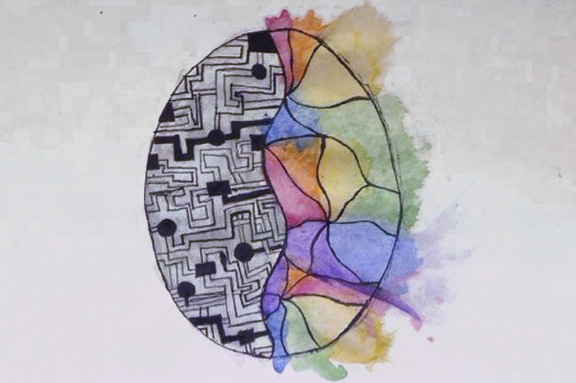The Mental Health Benefits of Art Are for Everyone
The following are excerpts from an article originally published by bebrainfit.com & written by Deane Alban
We are all born with an innate desire to express ourselves and art encompasses a wider range of activities than you may have ever imagined. Here are some of the best ways creative expression can benefit your brain and mental health to make you a happier, healthier person.
Creating Art Relieves Stress
Activities like painting, sculpting, drawing, and photography are relaxing and rewarding hobbies that can lower your stress levels and leave you feeling mentally clear and calm. Creating art provides a distraction, giving your brain a break from your usual thoughts. The average person has 60,000 thoughts per day and 95% of them are exactly the same day in, day out! When you get totally immersed in a creative activity, you may find yourself in what’s known as “the zone” or in a state of “flow.” This meditative-like state focuses your mind and temporarily pushes aside all your worries. Creating art trains you to concentrate on details and pay more attention to your environment. In this way, it acts like meditation.
Art Encourages Creative Thinking
Art enhances problem-solving skills. Unlike math, there is no one correct answer in art. Art encourages creative thinking and lets you come up with your own unique solutions. Out-of-the-box thinking also stimulates your brain to grow new neurons. Contrary to popular belief, creative thinking does not mean using the right side of your brain. It involves getting both hemispheres of your brain communicating with each other. The concept of left-brain right-brain dominance never had a strong foundation in science in the first place, and now this theory has been totally debunked. The most complicated activities humans do, such as learning a language or playing or listening to music, require whole brain thinking.
Art Boosts Self-Esteem and Provides a Sense of Accomplishment
You may stick your kids’ artwork on the refrigerator door to boost their self-esteem. Hanging your latest work of art on the wall can instill in you the same feeling. Creating art increases the “feel good” neurotransmitter dopamine. Dopamine has been called the “motivation molecule.” It boosts drive, focus, and concentration. It enables you to plan ahead and resist impulses so you can achieve your goals.It gives you that “I did it!” lift when you accomplish what you set out to do. Dopamine stimulates the creation of new neurons and prepares your brain for learning. You don’t have to produce fine art. Crafting hobbies of all kinds — knitting, quilting, sewing, drawing, photography, woodworking, gardening, and do-it-yourself home repair — increase dopamine, ward off depression, and protect the brain from aging.
Art Increases Brain Connectivity and Plasticity
Every time you engage in a new or complex activity, your brain creates new connections between brain cells. Your brain’s ability to grow connections and change throughout your lifetime is called brain plasticity or neuroplasticity. Creating art stimulates communication between various parts of the brain. In this way, creating art has been proven to increase psychological resilience and resistance to stress. It’s thought that intelligence depends more on the number of brain connections than the size of your brain.
Art Lessons Make Children Better Students for Life
Educators and parents alike have long suspected that music and arts programs make better students. Now, with neuroimaging, science can finally back this up. Children with musical training perform better in math, language, and reading. Early music lessons enhance brain plasticity and increase blood flow to the brain. There’s evidence that the brain-enhancing benefits of music lessons received during childhood can follow through adulthood and last a lifetime. The benefits of visual art programs are equally impressive. Art lessons increase brain plasticity, fluid intelligence, IQ, and attention. They improve overall behavior and reduce impulsiveness.
Art Increases Empathy, Tolerance, and Feelings of Love
A study of over 10,000 students found that a one-hour trip to an art museum changed the way they thought and felt. Students who visited a museum not only showed increased critical thinking skills, they also exhibited greater empathy towards how people lived in the past and expressed greater tolerance towards people different than themselves. Professor Semir Zeki, a neurobiologist at the University College London, discovered that simply the act of viewing art gives pleasure, much like falling in love. Brain scans revealed that looking at works of art trigger a surge of dopamine into the same area of the brain that registers romantic love.
Art Improves Quality of Life for Dementia Patients
Art enhances cognitive abilities and memory, even for people with serious brain disorders. Dementia is mainly thought of as a memory loss problem, but patients also experience symptoms such as agitation, aggression, anxiety, depression, and insomnia. Drug treatment for dementia symptoms is generally not very successful. When dementia patients are encouraged to create visual art, they derive obvious pleasure from it. It improves their social behavior and self-esteem, and reduces psychiatric symptoms.
Dr. Arnold Bresky is a physician who has created a program called the “Brain Tune Up” that utilizes art therapy for Alzheimer’s and dementia patients. He has seen a 70% success rate in improvement of his patients’ memories. By drawing and painting, patients are increasing connectivity between the right and left hemispheres of the brain and growing new brain cells.
Art Eases the Burden of Chronic Health Conditions
Millions of people deal with chronic health conditions and the stress, anxiety, and depression that accompanies them. Researchers analyzed and reported on the findings of over 100 studies done on the effects of art on physical and psychological health. They found that music and visual arts affected patients in these positive ways:
- Art let patients forget about their illness for a while, allowing them to focus on positive life experiences.
- Creating art enabled them to maintain the identity of who they were before they got sick.
- Creative activities gave them a sense of achievement.
- Art helped them express their feelings.
- Art reduced stress by lowering levels of the stress hormone cortisol.
Art Is for Everyone
Unless you have a health concern, seeing an art therapist is probably not necessary. ArtTherapyBlog.com puts it like this, “If it’s therapeutic for you to draw or paint a few times a week (without an art therapist), then I would consider that therapy. Who says art therapy always has to be professional?” Creating art isn’t just for those born with talent or for those in a position to work with a therapist. Art is for everyone!
Art Exercises to Do at Home
Albert Einstein said that “Creativity is intelligence having fun.” If it’s been a long time since you had fun expressing yourself creatively, you might not know where to begin. If that’s the case, you can check out a list of 100 Art Therapy Exercises. You don’t have to have any particular artistic skills to get started. Some exercises are craft-like, such as making a dream catcher. If you are more into “cut and paste” than drawing or painting, there are several ideas for creating collages. For those who are more analytical, you can start by creating a mind map to visualize your thoughts or feelings. If you don’t want to share what you are doing with others, use sand, chalk, or water to create temporary art. Remember as you are creating, that using art therapeutically is about the journey — not about the end product.
Creating Art vs Art Therapy
Anyone can benefit from creating art, but sometimes it’s best to seek the help of a professional. Art therapists are health care professionals with backgrounds in both art and psychology or counseling. Art therapy can be used to improve physical, mental, and emotional well-being. You should consider art therapy if you are experiencing any of the following situations: high stress occupation, mental health disorder, learning disability, brain injury or chronic illness. Art therapy is also recommended for children or teens who are having personal problems or trouble in school. Art used as therapy has successfully helped people with anxiety, depression, addictions, PTSD, chronic pain, cancer, high blood pressure, bipolar disorder, dementia and Alzheimer’s, and other serious health and mental health conditions.
Within each of us lies a spark of creativity.
Now that you know all the benefits artistic pursuits can provide, I hope you won’t put off exploring your artistic side any longer.
For a pdf version of this newsletter, follow this link:Photos for Healing Newsletter #112- May ’16



